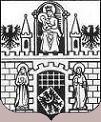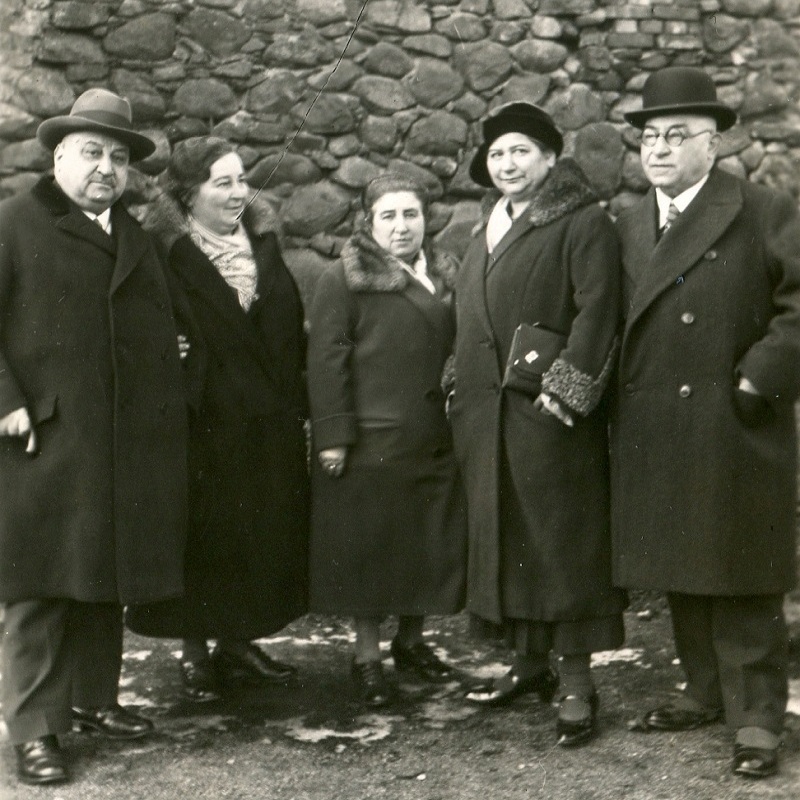
The Philippsberg familiy |
The Philippsberg Family
Simon, Margarete, Bianca, Gertrud und Hermann Philippsberg, 1932 in Lüben |
Before about 1860, the Philippsberg family lived in Lissa. Louis Philippsberg (born in 1832) married Ulrike Schlesinger (born in 1831) in 1858. They had a family of five sons and two daughters, and moved to Lüben around 1863. There is some confusion as to the occupation of Louis Philippsberg. According to my mother's memoirs, he had a men's outfitters business. However, recently discovered documents list him as a furrier. Did he perhaps sell men's clothing during the summer months and furs in the winter? The oldest son, Siegfried (born in 1859), married Regine Tischler and they had three daughters and one son. Siegfried died before the Second World War. His wife and oldest daughter were transported to Theresienstadt were they died. The same fate befell a young granddaughter whose mother managed to escape to England where she died in 1969. The only son, a dentist, and another daughter emigrated to the USA. Louis and Ulrika's son Simon (born in 1868) married Margarethe Meyer. They lived in Waldenburg (Wałbrzych) where they had a liquor factory as well as a bar on the ground floor of their house in the market place. They had two sons, Ludwig and Walter. Ludwig worked with his father and emigrated to Rio de Janeiro. Walter emigrated to Melbourne, Australia. Simon and Margarethe were transported from Breslau to Theresienstadt and then to Treblinka. Son Isidore married and lived in Belgium where he owned a business in electrical goods and lamps. He married twice, but had no children. Son Salomon (Salo, born in 1869) and his wife Margarethe Rosenthal lived in Neumarkt, a town between Liegnitz and Breslau, where they had a coal merchant business. They had a daughter, Lotte, who emigrated to Denmark where she married and had four daughters. Their son Hans lived in Lüben with his aunts Bianca and Amalie. He went to school there and later learned the fur business. He emigrated to Bolivia where he married and had four children, three sons and a daughter. Both Salo and his wife were transported to Theresienstadt, and from there to Treblinka on 31.08.1942. Louis and Ulrika's older daughter Amalie (Mally, born in 1863), was married for a short while and then divorced. She lived with her younger, unmarried sister Bianca (born in 1873) in Lüben. We now know that Bianca became the first female master furrier and had taken over her father's business after his death, in 1912. My mother recollected that Bianca had as customers a large number of wealthy farmers. She stored their fur coats during the summer months in large, wooden containers. She also remembered that during one long school holiday they went to visit these aunts. As food was in short supply, they went to farms to get butter and eggs and that the farmers were very nice to them. Bianca and Mally were transported to Treblinka on 23.09.1942. I know most about Hermann, the second son, because he was my grandfather. He was born in Lissa 1861 and two years' old when the family moved to Lüben. He must have learned the fur trade from his father and carried on with it after he had moved to Leipzig. Once a year he would travel to Russia, to St. Petersburg, Moskou and Nischninowgorod on the Wolga river, to buy furs. These were then sent on to Leipzig, the centre of the fur trade. The building where he worked, is still standing. He married Gertrud Bacher from Magdeburg, in 1895 and they had a family of four children - one son and three daughters. The family was very comfortably off and led a good, well-regulated Jewish life. They kept in close contact with other branches of the family. Not only was Hermann a good business man, he was also very sporty, for instance, he swam all the year round. This included having to break open the ice before getting into the water... He also skated and cycled. Besides German, he spoke English, French and Russian and told his children not to read rubbish but to learn languages. His wife died in 1935. As an old man, Hermann was forced to buy himself into "an old-aged home" in Theresienstadt where he died in November 1942. When his oldest daughter Elsa married, her husband Leo joined the business. They moved to Paris in 1931. Elsa died while on holiday in Leipzig, in 1934. Her husband and son were taken to the Drancy concentration camp and from there to Auschwitz where they died in September 1942. Hermann's only son was apprenticed to another furrier and after some years, followed in the family tradition. However, this was not to last. Just before World War II, he with his wife and young son, emigrated to America having spent a few years in Cuba first. In New York, he went into the jewellery trade. Hermann's daughter Lucie trained as a kindergarten teacher in Leipzig and worked as such for some years. Later she went to Berlin where she worked in a Jewish children's home. In 1939 she left for England and spent about ten years there. After the war she emigrated to the USA. She did not marry, but had a large circle of friends whom she entertained by playing the guitar as well as singing. She died in New York in 1956. The photograph on the right shows Lucie during a visit in 1928 to her aunts Bianca and Amalie (Mally) in Lueben. On the reverse she adds: “The new Lueben memorial! Juno and the famous kindergarten teacher Lucie!” At the time nobody forsaw that this boulder in the Schillerpark, would become a memorial in the so-called 'Heldenhain'. Lucie did not want to become a heroine, but only a famous kindergarten teacher! My mother, Margot, was the youngest daughter. Having left school, she worked for some ten years for a company dealing in leather used mainly for slippers. After her mother died, she ran the household for her father. She had a busy social life with a large circle of Jewish friends. Early in 1939, she left Nazi Germany, to work in England as a domestic servant in a private house. This was how many young women managed to get out of Germany. As mentioned, later that year, her sister Lucie came to England as well. My mother had been introduced by a mutual friend to, and corresponded with a German Jewish man living in Cape Town, South Africa. He had been there since 1933. They planned to get married though they only knew each other through letters. In May 1940, she left England by ship for South Africa. They married six weeks after her arrival, and remained so for more than 50 years.My brother married and now lives in Australia and has two sons. My younger sister and her daughter live in Cape Town while I live in London with my husband, two sons and two grandchildren. That is how Jewish families are spread over the world. Dorothy Obstfeld, London 2008Übersetzung ins Deutsche |
Gertrud Philippsberg 1890
Die Schwägerinnen Amalia und Gertrud Philippsberg 1900
Artur Philippsberg auf einer Postkarte aus Leipzig an den Großvater in Lüben, 1907
Die Postkarte von Hermann an seinen Vater Louis Philippsberg in Lüben, 1907
Gertrud, ihre Mutter Sidonie Bacher und Hermann Philippsberg, 1910 Auf die Rückseite schrieb Lucie: "Februar 1928. Das neue Lübener Denkmal: Juno und die berühmte Kindergärtnerin Lucie!" |






